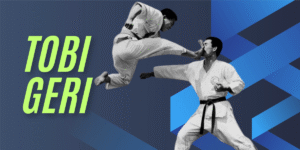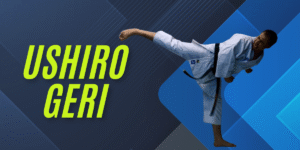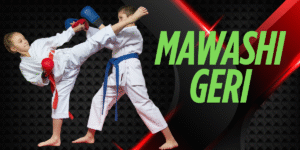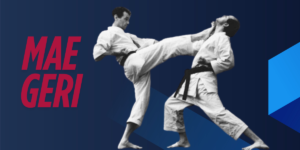The most picturesque pose of a karateka or in a fight scene of a movie is a kick. Nothing is more satisfying in karate than doing a proper karate kick, whether in sparring or practice.
Whether you’re a beginner or looking to level up your skills, understanding the different types of Karate kicks can take your practice to new heights.
In this guide, I will walk you through everything you need to know about Karate kicks.
From names of kicks (in both English and Japanese) to how you can improve your technique, speed, and power, I’ve got you covered. I’ll also answer some of the most common questions I’ve encountered regarding Karate kicks.
Understanding Karate Kicks
What is a Karate Kick?
A Karate kick is one of the core techniques used in martial arts to strike an opponent.
It involves using your legs to deliver a decisive blow, often aiming at the opponent’s midsection, head, or lower body.
The primary purpose of a Karate kick is to defend yourself or gain an advantage in a sparring match.
But even if you’re not in a fight, practicing Karate kicks helps improve your overall fitness, strength, and coordination. It’s a great way to increase flexibility, enhance reflexes, and develop mental focus.
Names of Karate Kicks
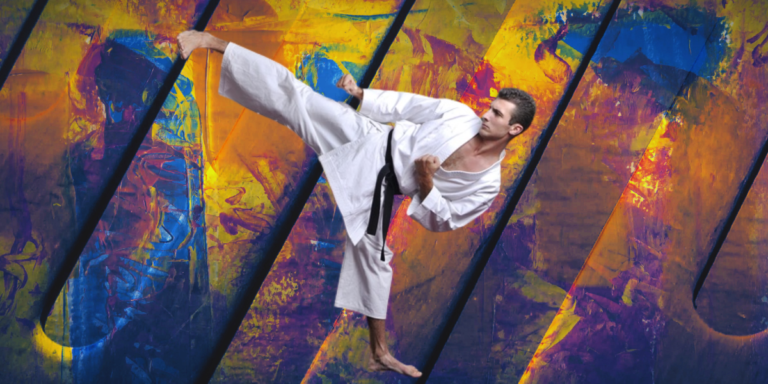
Karate Kick Name List
One of the most interesting things about Karate kicks is that many have English and Japanese names.
This not only adds to the tradition of Karate but also helps you understand the techniques more deeply.
Here’s a list of some of the most common Karate kicks, along with their names in both English and Japanese:
Front Kick (Mae Geri): This is the classic Karate kick you’ll learn first. “Mae” means front, and “Geri” implies kick, so “Mae Geri” literally translates to “Front Kick.” Variations of these kicks are below:
Mae Geri – Front Kick
Mae Geri Keage – Front Snap Kick
Mae Geri Kekomi – Front Thrust Kick
Mae Tobi Geri – Jumping Front Kick
Roundhouse Kick (Mawashi Geri): “Mawashi” means circular or around, while “Geri” again means kick. The roundhouse kick is about spinning your leg around, making it one of the most versatile and powerful. There are some variations of this powerful karate kick:
- Mawashi Geri – Roundhouse Kick
- Gedan Mawashi Geri – Low Level Roundhouse Kick
- Chudan mawashi geri- Center level Roundhouse kick
- Jodan Mawashi Geri- High level Roundhouse kick
- Ura Mawashi Geri – Reverse Roundhouse Kick or Hook Kick
- Ura Ushiro Mawashi Geri – Spinning Reverse Roundhouse Kick or Spinning Wheel Kick
- Otoshi Mawashi Geri – Downward Roundhouse Kick or Circular Falling Kick
Side Kick (Yoko Geri): “Yoko” means side, and “Geri” means kick. This kick is performed by turning your body sideways and striking with the edge of your foot. Yoko Geri has these variations:
- Yoko Geri – Side Kick
- Yoko Geri Keage – Side Snap Kick
- Yoko Geri Kekomi – Side Thrust Kick
- Yoko Tobi Geri – Jumping Side Kick or Flying Side Kick
Back Kick (Ushiro Geri): “Ushiro” means back or rear. This is a defensive kick where you turn your back on your opponent and strike behind you. This type of kick has this variation:
Jumping Kick( Tobi Geri): “Tobi” means To jump; Tobi Geri is a powerful karate kick. But it is pretty challenging to land this kick. Thus, only advanced-level karateka are allowed to practice this karate kick. The variations are:
- Tobi Geri – Jumping Kick
- Tobi Hiza Geri – Jumping Knee Strike
- Tobi Mae Geri or Mae Tobi Geri – Jumping Front Kick
- Tobi Mawashi Geri – Jumping Roundhouse Kick
- Tobi Ushiro Geri – Jumping Back Kick
- Tobi Yoko Geri or Yoko Tobi Geri – Jumping Side Kick or Flying Side Kick
- Nidan Tobi Geri (or Nidan Geri) – Jumping Double Front Kick
Axe Kick (Koumou Geri): “Koumou” refers to the shape of an axe, as the kick comes down sharply like an axe. It’s an excellent kick for targeting the opponent’s head or shoulders.
Crescent Kick (Mikazuki Geri): “Mikazuki” means crescent moon, and this kick is so named because of the sweeping, crescent shape it makes when performed.
Other Kicks: Some other kicks are:
- Ashi Barai – Foot Sweep
- Fumikomi – Stomp or Stomping Kick
- Hiza Geri – Knee Strike
- Kansetsu Geri – Joint Kick (usually attacking an opponent’s knee)
- Kin Geri – Groin Kick
- Tatsumaki Senpuu Kyaku – Tornado Kick
- Tsumasaki Geri – Toe Kick
- Uchi Haisoku Geri – Twist Kick, Instep Kick, etc
Common Questions of Beginners on How to Perform Karate Kicks
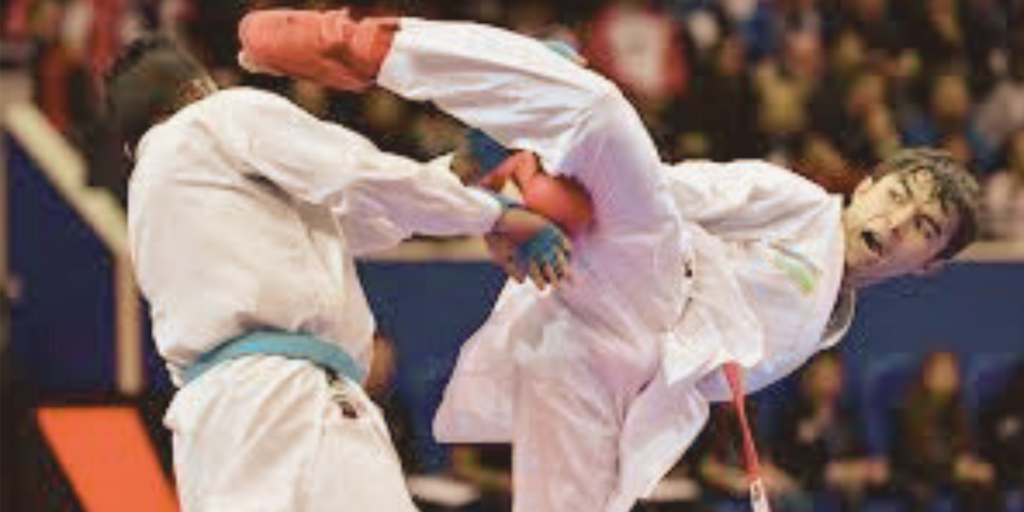
How Do You Karate Kick as a Beginner?
Karate kicks may look impressive, but they all start with the same basic principle: proper form and technique.
Whether throwing a front kick or a roundhouse, ensuring your body moves efficiently is key to a great kick. Here’s how to get started:
Stand in the Correct Stance: Make sure your body is balanced before you kick. You should be firm, like Zenkutsu Dachi (front stance) or Kiba Dachi (horse stance), with your feet shoulder-width apart for stability.
Chamber Your Kick: You must “chamber” your kick to generate power and control. This means bringing your knee up and across your body before you extend it. Think of it like winding up a spring.
Snap and Extend: Once your knee is up, snap your foot out quickly. The key is to strike fast and with precision, not just force. The faster and more controlled your kick, the stronger it will be.
Retract Quickly: Once your foot makes contact (or if you’re practicing), quickly retract your leg to the chambered position. This helps you maintain balance and get ready for the next move.
Land and Recover: After the kick, land softly, keeping your body weight centered. This ensures you don’t overbalance and can recover for the following action.
How to Kick Perfectly?
Perfecting your Karate kicks takes time, but there are a few tips that can help you improve your technique:
Focus on Flexibility: Improving your leg flexibility is essential to get your kicks high and fast. Stretch regularly, especially your hamstrings, hips, and lower back.
Use Your Hips: Many beginners make the mistake of kicking with just their legs. But in Karate, your hips play a huge role in generating power. Rotate your hips as you kick to add force.
Engage Your Core: A strong core helps with balance and control. Engage your abs and lower back muscles while kicking for better stability.
Practice Consistently: The more you practice, the better you’ll become. Start with slow, controlled movements, and gradually increase speed as you get more comfortable.
How to Kick Harder in Karate?
You must focus on strength and technique to increase the power behind your kicks. Here are a few ways to kick harder:
Strengthen Your Legs: Strong legs are the foundation of any powerful kick. Work on leg exercises like squats, lunges, and calf raises to build muscle.
Perfect Your Form: A kick will only be as powerful as the technique behind it. Focus on your posture, the speed of your kick, and the snap at the end to generate more force.
Use Your Hips and Core: As mentioned earlier, your hips and core are essential for power. The more you rotate your hips and engage your core muscles, the harder your kick will be.
Add Explosive Movement: To increase the force of your kick, practice explosive movements. Jump kicks, sprints, and plyometric exercises will help improve the speed and power of your kicks.
Advanced Karate Kick Techniques
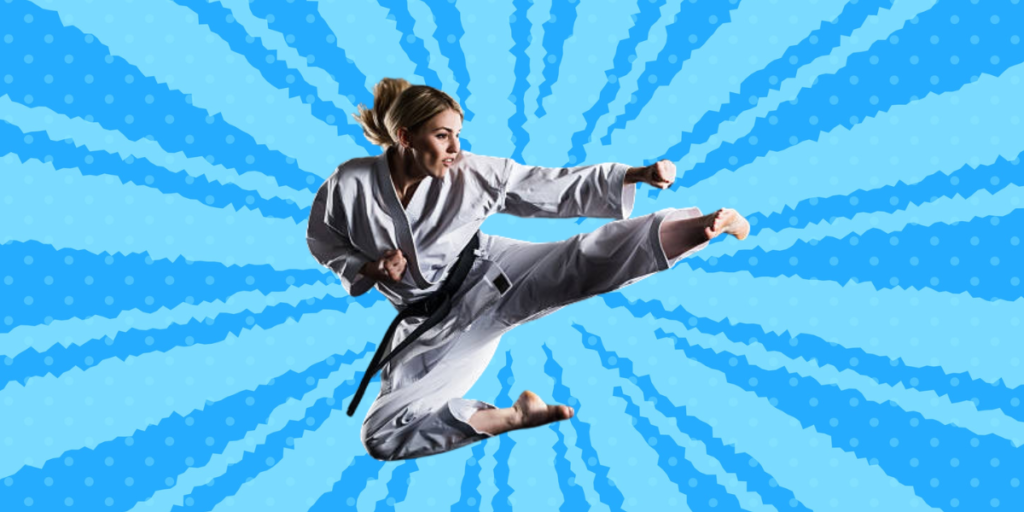
How Can I Increase My Kick Power?
Increasing the power of your Karate kicks isn’t just about kicking harder. It’s about building strength, improving technique, and effectively using the right muscle groups. Here’s how you can boost the power behind your kicks:
Strengthen Your Legs and Core: For strong kicks, you must have a strong core and legs. Focus on exercises like squats, deadlifts, and leg presses to build the necessary muscles for explosive kicks.
Improve Your Flexibility: Flexibility plays a huge role in kicking power. The more flexible your legs and hips are, the higher and more forceful your kicks can be. Regular stretching and yoga can help improve your range of motion, allowing for deeper, more powerful kicks.
Perfect Your Timing and Technique: The quicker you snap your foot, the more powerful your kick will be. Perfecting your technique and timing is key to delivering a punch of power. Practice your kicks slowly at first, then build up speed. Speed equals power in Karate!
Use Your Hips and Core Properly: When you kick, it’s not just your leg that should be involved. Use your hips and core to add force. As you kick, rotate your hips and engage your core. The more you rotate your hips and tighten your core muscles, the more power you generate.
Practice Fast and Slow Kicks: Power also comes from control. Practice both fast kicks for speed and slow kicks for control, as this helps you develop explosive power when you need it.
How Do I Give a Kick More Body?
When learning Karate kicks, focusing too much on the leg and foot is easy. But a powerful kick involves your entire body. Here’s how to make your kicks stronger and more controlled:
Engage Your Entire Body: Don’t rely on your leg for power – use your core, hips, and shoulders. As you throw your kick, engage your entire body to add more force and control.
Pivot on Your Foot: For kicks like the roundhouse or sidekick, pivoting your supporting foot is crucial. Pivoting allows your hips to rotate fully, giving the kick more body and making it more effective.
Stay Balanced: The more balanced you are, the more power you can put into your kicks. Focus on keeping your stance strong and your movements controlled to deliver more force.
Proper Kick Extension: Ensure your kick fully extends at the right time. Kicking too early or late can detract from your power and control. Focus on expanding your leg when you reach the right spot to strike.
How Can I Improve My Kick-Up?
People talking about “kick height” usually mean how high you can kick. Whether practicing a front kick or a roundhouse, getting your leg higher can be tough. But there are ways to improve your kick height:
Stretch regularly: Flexibility is the key to high kicks. Stretch your hamstrings, hip flexors, and calves regularly to increase your range of motion.
Use the Right Technique: To get your leg higher, focus on lifting your knee first and then extending your foot. The more you drive the knee up, the higher your kick will go.
Strengthen Hip Muscles: Hip strength plays a huge role in raising your legs. Exercises like leg lifts and hip thrusts will help build the muscles for high kicks.
Practice Kicking Slowly: This might be the most important thing to do to improve your kick quickly.In my early days, My Sensi made me practice kicks slowly. It may seem counterintuitive, but practicing kicks slowly can help you improve your balance and hip movement. By focusing on building strength, flexibility, and proper technique, you can improve your kicks’ power, body, and height. Practice consistently, and you’ll start seeing noticeable improvements in no time.
Common Questions and FAQs About Karate Kicks
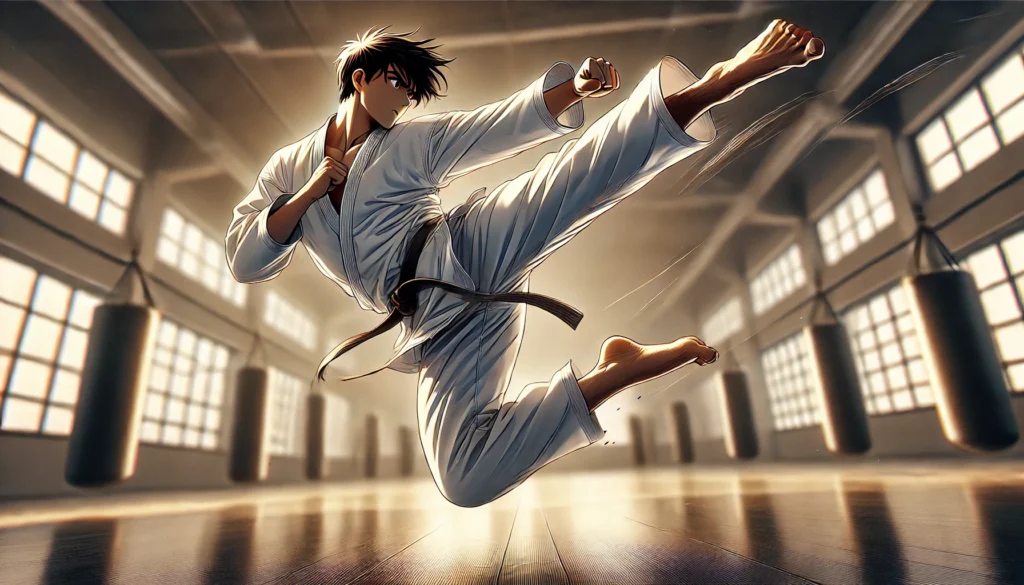
What Are the 8 Kicks in Karate?
In Karate, there isn’t an official “list” of just eight kicks. Still, many schools and instructors focus on mastering a few essential kicks that form the foundation of all Karate techniques.
While different Karate styles may emphasize different kicks, here’s a list of 8 commonly practiced kicks:
- Front Kick (Mae Geri) is a simple and powerful kick that is great for attacking your opponent’s midsection or head.
- Roundhouse Kick (Mawashi Geri) – A circular kick that strikes from the side, targeting the head or torso.
- Side Kick (Yoko Geri) – A lateral kick that’s strong for self-defense or breaking through defenses.
- Back Kick (Ushiro Geri) – A defensive kick aimed behind you, perfect for protecting your back.
- Spinning Back Kick (Tobi Ushiro Geri) – A powerful variation of the back kick that uses momentum from a spin.
- Axe Kick (Koumou Geri) – A downward kick that comes down like an axe, aimed at an opponent’s head.
- Crescent Kick (Mikazuki Geri) – A sweeping, crescent-shaped kick designed to hit the opponent’s head or body from the side.
- Hook Kick (Ura Mawashi Geri) – A kick that hooks around like a hook punch, perfect for targeting the opponent’s head or ribs.
In karate training, though, many schools may have their own versions or additional kicks on which they focus.
What Are Karate Kicks for Beginners?
If you’re starting out with Karate, there are a few kicks that you’ll focus on first.
These are simpler to execute and help build a strong foundation for more advanced techniques. The best Karate kicks for beginners are:
- Front Kick (Mae Geri): This is often the first kick students learn. It’s easy to perform and highly effective for targeting your opponent’s midsection or face.
- Side Kick (Yoko Geri): A solid foundational kick that works well in self-defense and sparring.
- Roundhouse Kick (Mawashi Geri): Though it requires more technique, this kick is essential for beginners to master, as it’s one of the most commonly used in Karate.
These three kicks form the basic building blocks for any new Karate student, and once you’re comfortable with them, you can move on to more advanced kicks like the back kick or spinning kicks.
That’s a wrap for the FAQ section! These are some of the most commonly asked questions regarding Karate kicks, and I hope this has helped clear up any confusion.
Conclusion
Karate kicks are mesmerizing, But it’s equally challenging to perform, especially during a match or in real-life situations.
There is a lot of variation in karate kicks; each kick has its own role and can be used in different situations.
Whether you’re a beginner or an experienced Karateka, understanding these kicks’ names, techniques, and purposes is essential to advancing your Karate practice.
I hope this guide has answered your questions and given you some tips to improve your kicks. Keep practicing, stay focused, and soon, you’ll notice how much stronger and faster your kicks become!
If you’re serious about mastering Karate kicks, I encourage you to find a dojo or a Karate instructor who can guide you through the more advanced techniques. With the proper training, you’ll soon be kicking like a pro!
You Might Also Like






